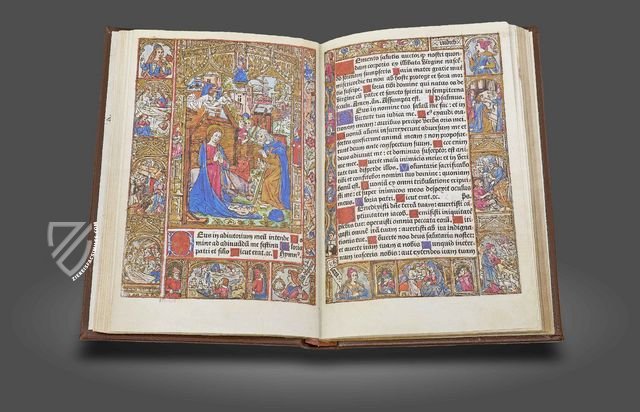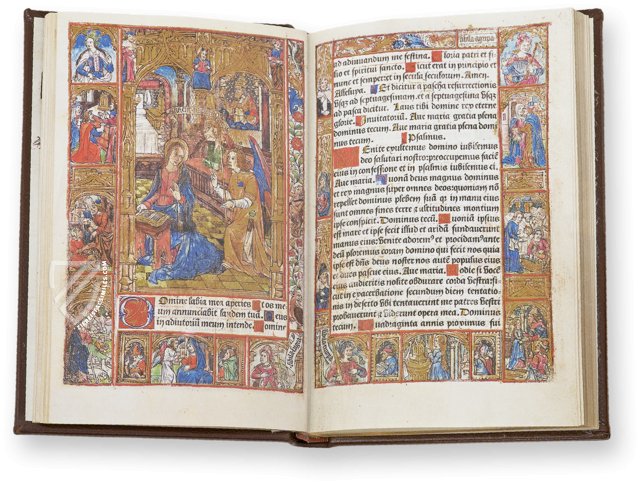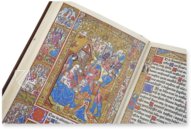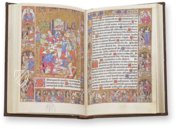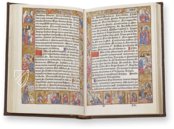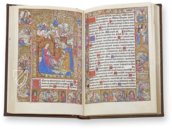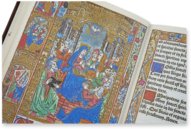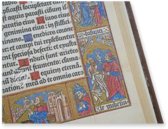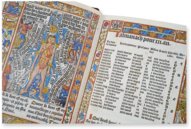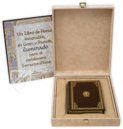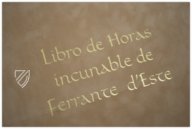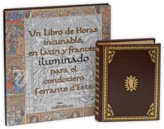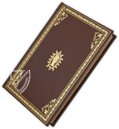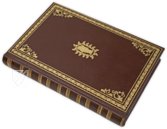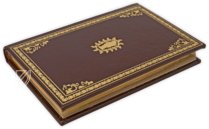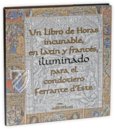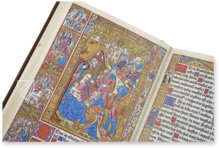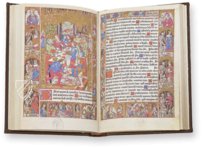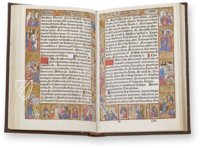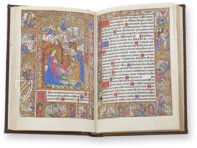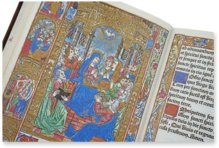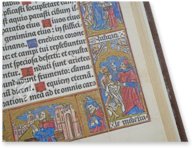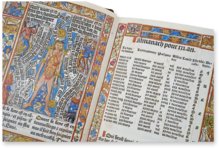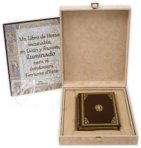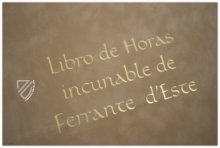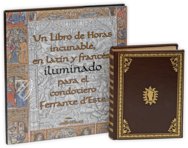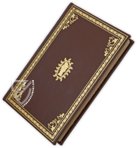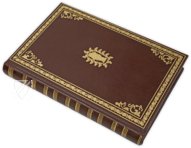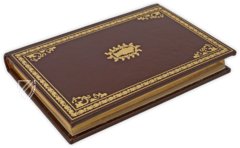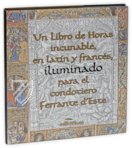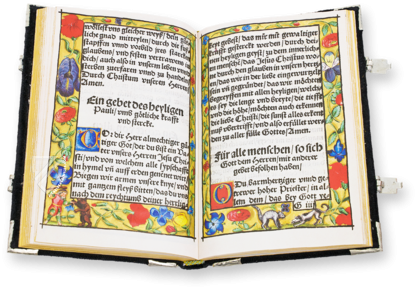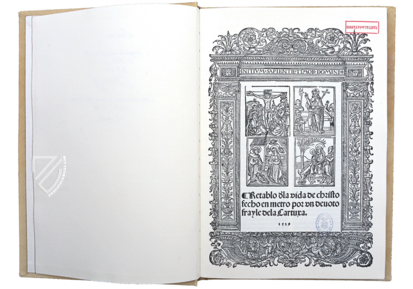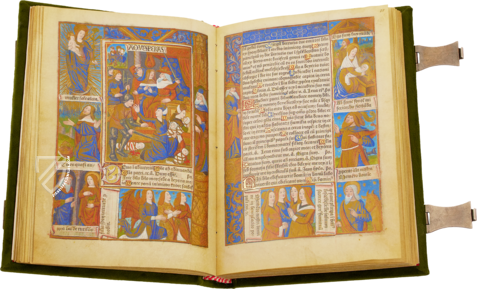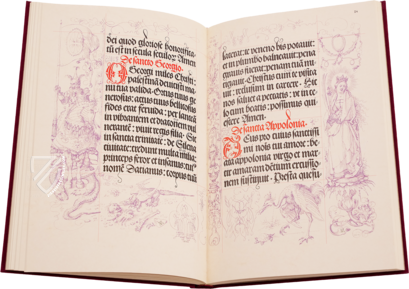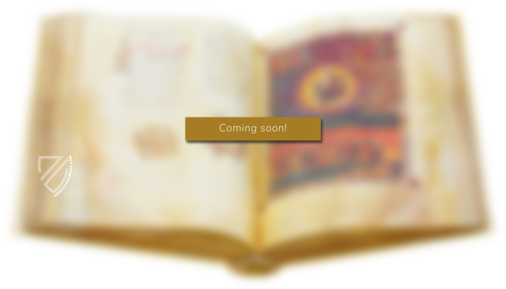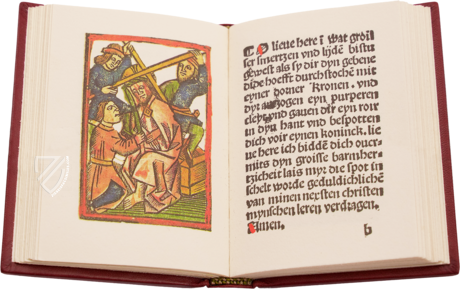Incunabular Book of Hours in Latin and French Illuminated for the Condotiere Ferrante d'Este
(1,000€ - 3,000€)
The so-called Incunabular Book of Hours of Ferrante d’Este is a true masterpiece of early book-printing. This Heures à l´usage de Rome was made in the great tradition of illumination by Simon Vostre in Paris. The 190 pages of the book are pictorially adorned all over: 48 miniatures, 18 of them full-page, and 182 splendid frames with small image medallions constitute the lavish book adornment of this incunabula. The prints were wonderfully colored and accompany the text in two languages: Latin and French. The owner of this magnificent and precious edition was Ferrante d’Este, a scion of the famous noble family of Ferrara.
Incunabular Book of Hours in Latin and French Illuminated for the Condotiere Ferrante d'Este
The so-called Incunabular Book of Hours of Ferrante d’Esteis a true masterpiece of early book-printing. This book of hours adhering to the Roman liturgy was made in the great tradition of illumination by Simon Vostre in Paris. The 190 pages of the book are pictorially adorned all over: 48 miniatures, 18 of them full-page, and 182 splendid frames with small image medallions constitute the lavish book adornment of this incunabula. The prints were wonderfully colored and accompany the text in two languages: Latin and French. The owner of this magnificent and precious edition was Ferrante d’Este, a scion of the famous noble family of Ferrara.
A Masterpiece by Vostre and Pigochet
This impressive attestation of early printing is stored in the Spanish National Library in Madrid. The book of hours arose in the year 1496 in the Parisian workshop of Philippe Pigouchet – dated August 20th, 1496 exactly. Pigouchet was one of the most important French printers of the late 15th century and worked together with Simon Vostre. Simon Vostre, a significant book dealer and publisher, also produced this book of hours together with Pigouchet.
A Printed Book of Hours
This incunabular book of hours – the Heures à l´usage de Rome – originates from the greatest tradition of medieval manuscripts. It represents therewith a gorgeous connection between old and new, of the great book art of the Middle Ages and the innovative technique of book printing. The tradition of handwritten books of hours, as they had conventionally been for centuries, was continued in this way!
A Colorful Specimen for the Italian Nobleman
This specimen from the Spanish National Library was in the possession of Ferrante d’Este. Ferrante d’Este (1477–1540), the son of Ercole d’Este (1431–1505), the Duke of Ferrara, was descended from the significant Italian aristocratic family of Este. The masterful prints in his personal edition of the book of hours are gorgeously and elaborately colored. Additionally, the book of hours contains the text of the Psalms, prayers, and other content in two languages: French was also written down alongside the Latin text!
Decoration Rich with Imagery
Of the 190 pages of the incunabular book of hours, 48 are adorned with miniatures, 18 of them full-page. Additionally, 182 gorgeous and elaborate frames are worthy of mention, which adorn picture- and text-pages alike. The picture-pages are filled to capacity with figurative scenes and ornamentation. A large primary miniature in the middle is always surrounded by a broad frame, in which additional smaller scenes are integrated. Architectural elements and floral ornamentation build these frames, with which the pages of text are also elaborately adorned. The countless small scenes in compartmentalized paintings were colored with great skill.
Codicology
- Alternative Titles
- Libro de Horas incunable, en latín y francés, Iluminado para el Condotiero Ferrante d'Este
Inkunabel-Stundenbuch in lateinischer und französischer Sprache illuminiert für den Condottiere Ferrante d'Este - Size / Format
- 190 pages / 21.0 × 12.0 cm
- Origin
- France
- Date
- 1496
- Epochs
- Style
- Genre
- Illustrations
- 48 illuminations, 18 of them full-page. 182 frames made up of over 1100 pieces of various sizes. Initials in indigo or crimson, capital letters touched with yellow.
- Patron
- Simon Vostre (d. 1521)
- Artist / School
- Philippe Pigouchet workshop
- Previous Owners
- Ferrante d'Este (1477–1540)
Incunabular Book of Hours in Latin and French Illuminated for the Condottiere Ferrante d'Este
Martyrdom of Saint John
Although most modern scholars agree that the author of the Book of Revelation was John of Patmos, during the Middle Ages it was still believed that it was the work of John the Evangelist, who wrote the Fourth Gospel. Medieval iconography concerning him is rooted in the apocryphal Acts of St. John, wherein he is martyred when plunged into a vat of boiling oil. Typically presented at the beginning of Apocalypse manuscripts, it is recreated here in a beautifully detailed and colored woodcut
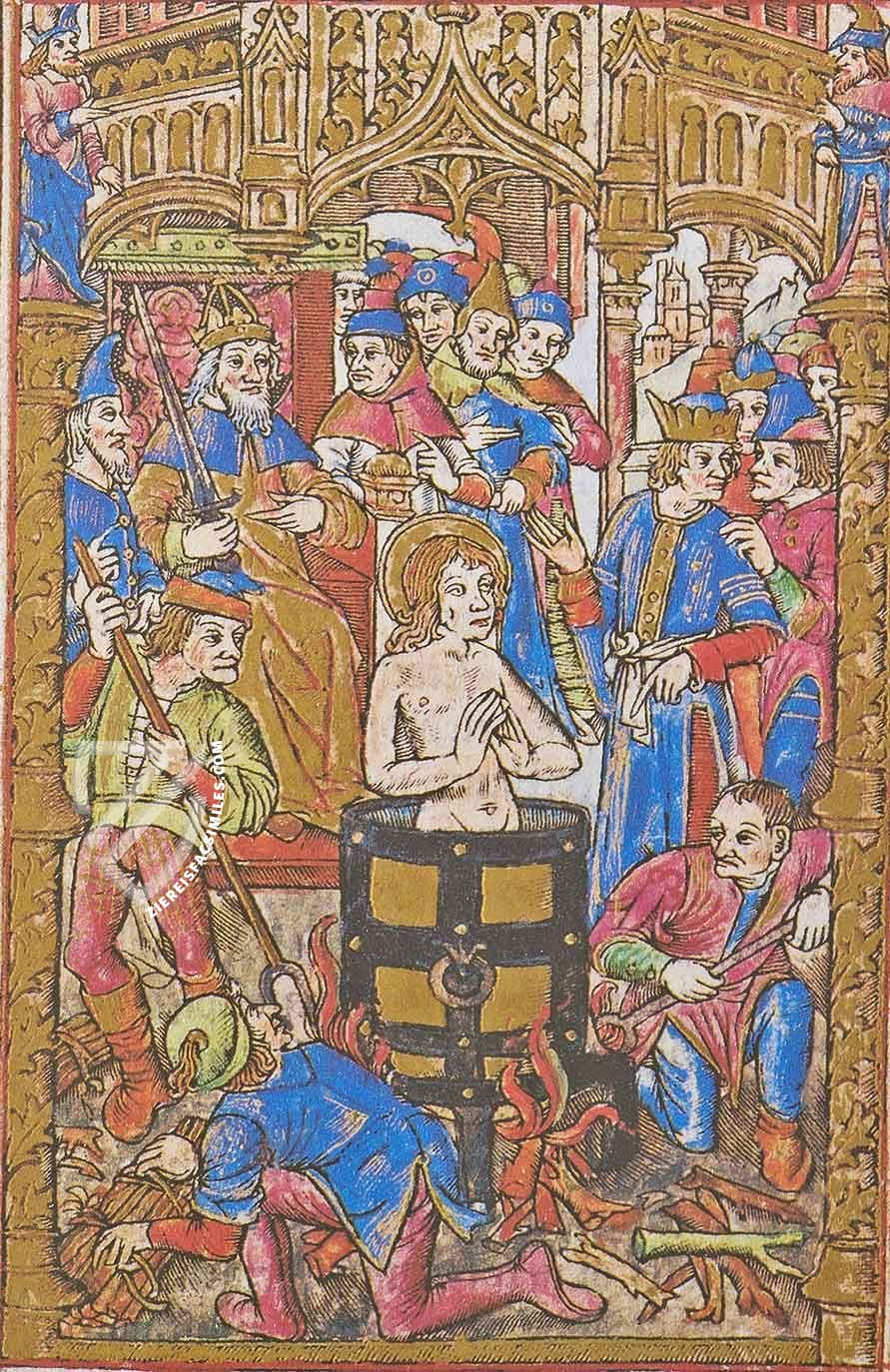
Incunabular Book of Hours in Latin and French Illuminated for the Condotiere Ferrante d'Este
Frontispiece
Although the shield is now painted over with the coat of arms of Ferrante d’ Este, the heraldic devices and worn paint in the banner below the miniature provide insight into its history. A wild, hairy-legged man and woman standing astride a pine tree was the symbol of Philippe Pigouchet, one of the most important early French engravers and printers, whose name is also revealed beneath the flaking gold-blue lettering.
The marginalia of this page is rendered with as much artistry as the primary image, with drolleries being a particularly delightful feature. Interspersed among the flowering tendrils, one finds winged dragons, beasts wearing human clothing, and apes riding goats and jousting with broomsticks on the backs of strange beasts.
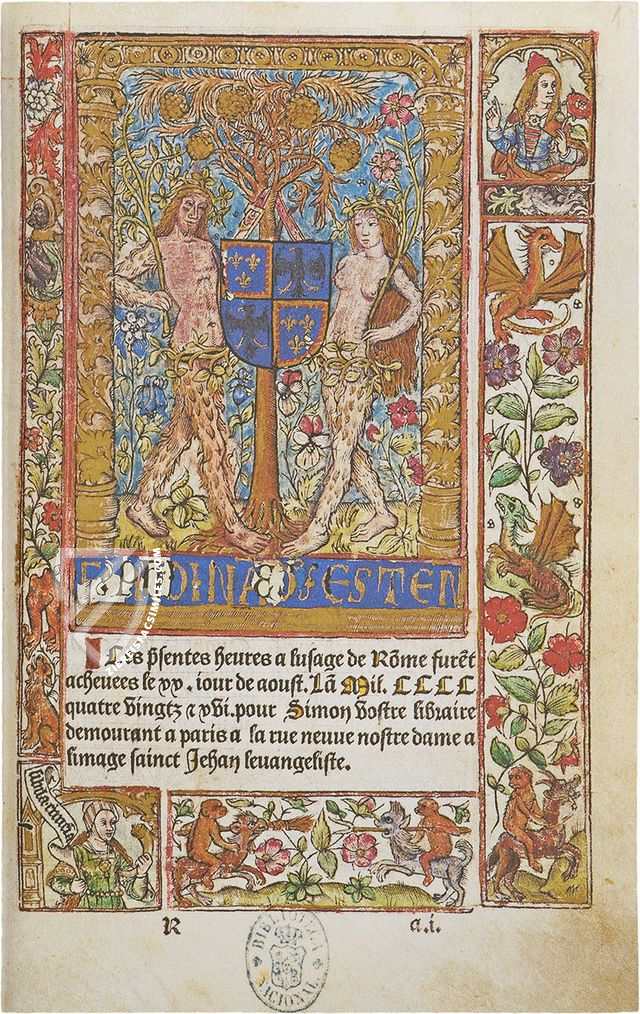
#1 Libro de Horas incunable, en latín y francés, del Condotiero Ferrante d'Este
Language: Spanish
(1,000€ - 3,000€)
- Treatises / Secular Books
- Apocalypses / Beatus
- Astronomy / Astrology
- Bestiaries
- Bibles / Gospels
- Chronicles / History / Law
- Geography / Maps
- Saints' Lives
- Islam / Oriental
- Judaism / Hebrew
- Single Leaf Collections
- Leonardo da Vinci
- Literature / Poetry
- Liturgical Manuscripts
- Medicine / Botany / Alchemy
- Music
- Mythology / Prophecies
- Psalters
- Other Religious Books
- Games / Hunting
- Private Devotion Books
- Other Genres
- Afghanistan
- Armenia
- Austria
- Belgium
- Belize
- Bosnia and Herzegovina
- China
- Colombia
- Costa Rica
- Croatia
- Cyprus
- Czech Republic
- Denmark
- Egypt
- El Salvador
- Ethiopia
- France
- Germany
- Greece
- Guatemala
- Honduras
- Hungary
- India
- Iran
- Iraq
- Israel
- Italy
- Japan
- Jordan
- Kazakhstan
- Kyrgyzstan
- Lebanon
- Liechtenstein
- Luxembourg
- Mexico
- Morocco
- Netherlands
- Palestine
- Panama
- Peru
- Poland
- Portugal
- Romania
- Russia
- Serbia
- Spain
- Sri Lanka
- Sweden
- Switzerland
- Syria
- Tajikistan
- Turkey
- Turkmenistan
- Ukraine
- United Kingdom
- United States
- Uzbekistan
- Vatican City
- A. Oosthoek, van Holkema & Warendorf
- Aboca Museum
- Ajuntament de Valencia
- Akademie Verlag
- Akademische Druck- u. Verlagsanstalt (ADEVA)
- Aldo Ausilio Editore - Bottega d’Erasmo
- Alecto Historical Editions
- Alkuin Verlag
- Almqvist & Wiksell
- Amilcare Pizzi
- Andreas & Andreas Verlagsbuchhandlung
- Archa 90
- Archiv Verlag
- Archivi Edizioni
- Arnold Verlag
- ARS
- Ars Magna
- ArtCodex
- AyN Ediciones
- Azimuth Editions
- Badenia Verlag
- Bärenreiter-Verlag
- Belser Verlag
- Belser Verlag / WK Wertkontor
- Benziger Verlag
- Bernardinum Wydawnictwo
- BiblioGemma
- Biblioteca Apostolica Vaticana (Vaticanstadt, Vaticanstadt)
- Bibliotheca Palatina Faksimile Verlag
- Bibliotheca Rara
- Boydell & Brewer
- Bramante Edizioni
- Bredius Genootschap
- Brepols Publishers
- British Library
- C. Weckesser
- Caixa Catalunya
- Canesi
- CAPSA, Ars Scriptoria
- Caratzas Brothers, Publishers
- Carus Verlag
- Casamassima Libri
- Centrum Cartographie Verlag GmbH
- Chavane Verlag
- Christian Brandstätter Verlag
- Circulo Cientifico
- Club Bibliófilo Versol
- Club du Livre
- CM Editores
- Collegium Graphicum
- Collezione Apocrifa Da Vinci
- Comissão Nacional para as Comemorações dos Descobrimentos Portugueses
- Coron Verlag
- Corvina
- CTHS
- D. S. Brewer
- Damon
- De Agostini/UTET
- De Nederlandsche Boekhandel
- De Schutter
- Deuschle & Stemmle
- Deutscher Verlag für Kunstwissenschaft
- DIAMM
- Droz
- E. Schreiber Graphische Kunstanstalten
- Ediciones Boreal
- Ediciones Grial
- Ediclube
- Edições Inapa
- Edilan
- Editalia
- Edition Deuschle
- Edition Georg Popp
- Edition Leipzig
- Edition Libri Illustri
- Editiones Reales Sitios S. L.
- Éditions de l'Oiseau Lyre
- Editions Medicina Rara
- Editorial Casariego
- Editorial Mintzoa
- Editrice Antenore
- Editrice Velar
- Edizioni Edison
- Egeria, S.L.
- Eikon Editores
- Electa
- Emery Walker Limited
- Enciclopèdia Catalana
- Eos-Verlag
- Ephesus Publishing
- Ernst Battenberg
- Eugrammia Press
- Extraordinary Editions
- Fackelverlag
- Facsimila Art & Edition
- Facsimile Editions Ltd.
- Facsimilia Art & Edition Ebert KG
- Faksimile Verlag
- Feuermann Verlag
- Folger Shakespeare Library
- Franco Cosimo Panini Editore
- Friedrich Wittig Verlag
- Fundación Hullera Vasco-Leonesa
- G. Braziller
- Gabriele Mazzotta Editore
- Gebr. Mann Verlag
- Gesellschaft für graphische Industrie
- Getty Research Institute
- Giovanni Domenico de Rossi
- Giunti Editore
- Graffiti
- Grafica European Center of Fine Arts
- Guido Pressler
- Guillermo Blazquez
- Gustav Kiepenheuer
- H. N. Abrams
- Harrassowitz
- Harvard University Press
- Helikon
- Hendrickson Publishers
- Henning Oppermann
- Herder Verlag
- Hes & De Graaf Publishers
- Hoepli
- Holbein-Verlag
- Houghton Library
- Hugo Schmidt Verlag
- Idion Verlag
- Il Bulino, edizioni d'arte
- ILte
- Imago
- Insel Verlag
- Insel-Verlag Anton Kippenberger
- Instituto de Estudios Altoaragoneses
- Instituto Nacional de Antropología e Historia
- Introligatornia Budnik Jerzy
- Istituto dell'Enciclopedia Italiana - Treccani
- Istituto Ellenico di Studi Bizantini e Postbizantini
- Istituto Geografico De Agostini
- Istituto Poligrafico e Zecca dello Stato
- Italarte Art Establishments
- Jan Thorbecke Verlag
- Johnson Reprint Corporation
- Josef Stocker
- Josef Stocker-Schmid
- Jugoslavija
- Karl W. Hiersemann
- Kasper Straube
- Kaydeda Ediciones
- Kindler Verlag / Coron Verlag
- Kodansha International Ltd.
- Konrad Kölbl Verlag
- Kurt Wolff Verlag
- La Liberia dello Stato
- La Linea Editrice
- La Meta Editore
- Lambert Schneider
- Landeskreditbank Baden-Württemberg
- Leo S. Olschki
- Les Incunables
- Liber Artis
- Library of Congress
- Libreria Musicale Italiana
- Lichtdruck
- Lito Immagine Editore
- Lumen Artis
- Lund Humphries
- M. Moleiro Editor
- Maison des Sciences de l'homme et de la société de Poitiers
- Manuscriptum
- Martinus Nijhoff
- Maruzen-Yushodo Co. Ltd.
- MASA
- Massada Publishers
- McGraw-Hill
- Metropolitan Museum of Art
- Militos
- Millennium Liber
- Müller & Schindler
- Nahar - Stavit
- Nahar and Steimatzky
- National Library of Wales
- Neri Pozza
- Nova Charta
- Oceanum Verlag
- Odeon
- Orbis Mediaevalis
- Orbis Pictus
- Österreichische Staatsdruckerei
- Oxford University Press
- Pageant Books
- Parzellers Buchverlag
- Patrimonio Ediciones
- Pattloch Verlag
- PIAF
- Pieper Verlag
- Plon-Nourrit et cie
- Poligrafiche Bolis
- Presses Universitaires de Strasbourg
- Prestel Verlag
- Princeton University Press
- Prisma Verlag
- Priuli & Verlucca, editori
- Pro Sport Verlag
- Propyläen Verlag
- Pytheas Books
- Quaternio Verlag Luzern
- Reales Sitios
- Recht-Verlag
- Reichert Verlag
- Reichsdruckerei
- Reprint Verlag
- Riehn & Reusch
- Roberto Vattori Editore
- Rosenkilde and Bagger
- Roxburghe Club
- Salerno Editrice
- Saltellus Press
- Sandoz
- Sarajevo Svjetlost
- Schöck ArtPrint Kft.
- Schulsinger Brothers
- Scolar Press
- Scrinium
- Scripta Maneant
- Scriptorium
- Shazar
- Siloé, arte y bibliofilia
- SISMEL - Edizioni del Galluzzo
- Sociedad Mexicana de Antropología
- Société des Bibliophiles & Iconophiles de Belgique
- Soncin Publishing
- Sorli Ediciones
- Stainer and Bell
- Studer
- Styria Verlag
- Sumptibus Pragopress
- Szegedi Tudomànyegyetem
- Taberna Libraria
- Tarshish Books
- Taschen
- Tempus Libri
- Testimonio Compañía Editorial
- Thames and Hudson
- The Clear Vue Publishing Partnership Limited
- The Facsimile Codex
- The Folio Society
- The Marquess of Normanby
- The Richard III and Yorkist History Trust
- Tip.Le.Co
- TouchArt
- TREC Publishing House
- TRI Publishing Co.
- Trident Editore
- Tuliba Collection
- Typis Regiae Officinae Polygraphicae
- Union Verlag Berlin
- Universidad de Granada
- University of California Press
- University of Chicago Press
- Urs Graf
- Vallecchi
- Van Wijnen
- VCH, Acta Humaniora
- VDI Verlag
- VEB Deutscher Verlag für Musik
- Verlag Anton Pustet / Andreas Verlag
- Verlag Bibliophile Drucke Josef Stocker
- Verlag der Münchner Drucke
- Verlag für Regionalgeschichte
- Verlag Styria
- Vicent Garcia Editores
- W. Turnowski Ltd.
- W. Turnowsky
- Waanders Printers
- Wiener Mechitharisten-Congregation (Wien, Österreich)
- Wissenschaftliche Buchgesellschaft
- Wissenschaftliche Verlagsgesellschaft
- Wydawnictwo Dolnoslaskie
- Xuntanza Editorial
- Zakład Narodowy
- Zollikofer AG

